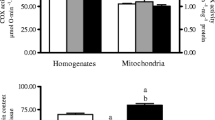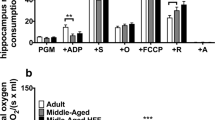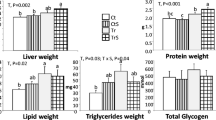Abstract
Caloric restriction (CR) decreases aging rate and lowers the rate of reactive oxygen species (ROS) production at mitochondria in different organs, but the signal responsible for this last change is unknown. Glucocorticoids could constitute such a signal since it is well known that their levels increase during CR, and available studies failed to find consistent effects of insulin, the other better described hormone that varies during CR, on mitochondrial oxidative stress. In addition, there is almost no information on the possible in vivo effects of glucocorticoids on specific markers of mitochondrial and tissue oxidative stress. In this investigation, male Wistar rats were treated with corticosterone at doses of 150 and 400 mg/kg of diet during 4 weeks. After that time, oxidative stress-related parameters were measured in the liver. The corticosterone treatments did not change the rate of ROS production or the rate of oxygen consumption of rat liver mitochondria. The two lipoxidation protein markers measured (malondialdehyde-lysine and carboxymethyllysine) were decreased by both corticosterone treatments. These changes were associated with decreases in fatty acid unsaturation, especially with lowered levels of the highly unsaturated araquidonic and docosahexaenoic acids, which decrease the sensitivity to lipid peroxidation processes. The specific protein carbonyl glutamic semialdehyde, a marker of protein oxidation, was also lowered at 400 mg/kg corticosterone. The protein glycoxydation marker carboxyethyllysine and the level of oxidative damage to mtDNA (8–oxo-7,8-dihydro-2 9-deoxyguanosine) were increased by corticosterone. The results do not support the idea that corticosterone is the signal responsible for the decrease in mitochondrial ROS generation during CR. However, they show that this hormone modulates the level of oxidative stress both in proteins and in mtDNA. Some of these changes can contribute to the chronic effects of the hormone at tissue level.
Similar content being viewed by others
Abbreviations
- AASA:
-
aminoadipic semialdehyde in proteins
- CEL:
-
carboxyethyl-lysine in proteins
- CML:
-
carboxymethyl-lysine in proteins
- DBI:
-
double bond index
- GSA:
-
glutamic semialdehyde in proteins
- MDAL:
-
malondialdehyde-lysine in proteins
- MitROS:
-
mitochondrial ROS
- MtDNA:
-
mitochondrial DNA
- 8-oxodG:
-
8-oxo-7,8-dihydro-2 9-deoxyguanosine
- ROS:
-
reactive oxygen species
References
Ahmed MU, Brinkmann-Frye E, Degenhardt TP, Thorpe SR, Baynes JW (1997) Nε-(carboxyethyl)lysine, a product of the chemical modification of proteins by methylglyoxal, increases with age in human lens proteins. Biochem J 324:565–570
Asunción JG, Millan A, Pla R, Bruseghini L, Esteras A, Pallardo FV, Sastre J, Viña J (1996) Mitochondrial glutathione oxidation correlates with age-associated oxidative damage to mitochondrial DNA. FASEB J 10:333–338
Barja G (2002) The quantitative measurement of H2O2 generation in isolated mitochondria. J Bioenerg Biomembr 34:227–233
Barja G (2004) Aging in vertebrates and the effect of caloric restriction: a mitochondrial free radical production-DNA damage mechanism? Biol Rev 79:235–251
Bartke A, Wright JC, Mattison JA, Ingram DK, Miller RA, Roth GS (2001) Longevity: extending the lifespan of long-lived mice. Nature 414:412
Bielski BHJ, Arudi RI, Sutherland MW (1983) A study of the reactivity of HO2/O -2 with unsaturated fatty acids. J Biol Chem 258:4759–4761
Brenner RR, Ayala S, Garda HA (2001) Effect of dexamethasone on the fatty acid composition of total liver microsomal lipids and phosphatidylcholine molecular species. Lipids 36:1337–1345
Cook HW (1996) Fatty acid desaturation and chain elongation in eukaryotes. In: Vance DE, Vance JE (eds) Biochemistry of lipids, lipoproteins and biomembranes, Elsevier, Amsterdam, pp129–152
Gomez Dumm IN, Raimondi C, Touceda L, Fassit JC (1999) Effect of methyl-prednisone and cyclosporine on the lipid pattern and polyunsaturated fatty acid biosynthesis in the rat. Acta Physiol Pharmacol Ther Latinoam 49:124–133
Gonzalez AA, Kumar R, Mulligan JD, Davis AJ, Weindruch R, Saupe KW (2004) Metabolic adaptations to fasting and chronic caloric restriction in heart, muscle, and liver do not include changes in AMPK activity. Am J Physiol 287:E1032–E1037
Gredilla R, Barja G (2005) Caloric restriction, aging and oxidative stress. Endocrinology 146:3713–3717
Gredilla R, Barja G, López-Torres M (2001) Effect of short-term caloric restriction on H2O2 production and oxidative DNA damage in rat liver mitochondria, and location of the free radical source. J Bioenerg Biomembr 33:279–287
Harris SB, Gunion MW, Rosenthal MJ, Walford RL (1994) Serum glucose, glucose tolerance, corticosterone and free fatty acids during aging in energy restricted mice. Mech Ageing Dev 73:209–221
Iuchi T, Akaike M, Mitsui T, Ohshima Y, Shintani Y, Azuma H, Matsumoto T (2003) Glucocorticoid excess induces superoxide production in vascular endothelial cells and elicits vascular endothelial dysfunction. Circ Res 92:81–87
Julian D, Leeuwenburgh Ch (2004) Linkage between insulin and the free radical theory of aging. Am J Physiol 286:R20–R21
Klebanov S, Diais S, Stavinoha WB, Suh Y, Nelson JF (1995) Hyperadrenocorticism, attenuated inflammation, and the life-prolonging action of food restriction in mice. J Gerontol 50A:B78–B82
Knecht KJ, Dunn JA, McFarland KF, McCance DR, Lyons TJ, Thorpe SR, Baynes JW (1991) Effects of diabetes and aging on Nε-(carboxymethyl)lysine levels in human urine. Diabetes 40:190–196
Latorre A, Moya A, Ayala A (1986) Evolution of mitochondrial DNA in Drosophila suboscura. PNAS USA 83:8649–8653
Lin H, Decuypere E, Buyse J (2004) Oxidative stress induced by corticosterone administration in broiler chickens (Gallus gallus domesticus)1. Chronic exposure. Comp Biochem Physiol 139B:737–744
Loft S, Poulsen HE (1999) Markers of oxidative damage to DNA: antioxidants and molecular damage. Method Enzymol 300:166–184
Mitsui T, Umaki Y, Nagasawa M, Akaike M, Aki K, Azuma H, Ozaki S, Odomi M, Matsumoto T (2002) Mitochondrial damage in patients with long-term corticosteroid therapy: development of oculoskeletal symptoms similar to mitochondrial disease. Acta Neuropathol 194:260–266
Odedra BR, Bates PC, Millward DJ (1983) Time course of the effect of catabolic doses of corticosterone on protein turnover in rat skeletal muscle and liver. Biochem J 214:617–627
Pandya JD, Agarwal NA, Katvare SS (2004) Effect of dexamethasone treatment on oxidative energy metabolism in rat liver mitochondria during postnatal developmental periods. Drug Chem Toxicol 27:389–403
Pamplona R, Dalfo E, Ayala V, Bellmunt MJ, Prat J, Ferrer I, Portero-Otin M (2005) Proteins in human brain cortex are modified by oxidation, glycoxidation, and lipoxidation. J Biol Chem 280:21522–21530
Requena JR, Fu MX, Amed MU, Jenkins AJ, Lyons TJ, Baynes JW, Thorpe SR (1997) Quantification of malondialdehyde and 4-hydroxynonenal adducts to lysine residues in native and oxidized human low-density lipoproteins. Biochem J 322:317–325
Requena JR, Chao CC, Levine RL, Stadtman ER (2001) Glutamic and aminoadipic semialdehydes are the main carbonyl products of metal-catalyzed oxidation of proteins. PNAS USA 98:69–74
Roussel D, Dumas JF, Simard G, Malthiery Y, Ritz P (2004) Kinetics and control of oxidative phosphorylation in rat liver mitochondria after dexamethasone treatment. Biochem J 382:491–499
Sanz A, Caro P, Barja G (2004) Protein restriction without strong caloric restriction decreases mitochondrial oxygen radical production and oxidative DNA damage in rat liver. J Bioenerg Biomembr 36:545–552
Sanz A, Gredilla R, Pamplona R, Portero-Otín M, Vara E, Tresguerres JAF, Barja G (2005) Effect of insulin and growth hormone on rat heart and liver oxidative stress in control and caloric restricted animals. Biogerontology 6:15–26
Sanz A, Caro P, Ayala V, Portero-Otin M, Pamplona R, Barja G (2006) Methionine restriction decreases mitochondrial oxygen radical generation and leak as well as oxidative damage to mitochondrial DNA and proteins. FASEB J (In press)
Suzuki H, Swei A, Zweifach BW, Schmid-Schönbein GW (1995) In vivo evidence for microvascular oxidative stress in spontaneously hypertensive rats: hydroethidine micofluorography. Hypertension 25:1083–1089
Zhu Z, Jiang W, Thompson HJ (1998) Effect of corticosterone administration on mammary gland development and p27 expression and their relationship to the effects of energy restriction on mammary carcinogenesis. Carcinogenesis 19:2101–2106
Acknowledgements
This study was supported in part by I + D grants from the Spanish Ministry of Science and Technology (BFI2003–01287), the Generalitat of Catalunya (Department d 9Universitats, Recerca, i Societat de la Informació, DURSI, ref. 2005SGR00101), and the Spanish Ministry of Health (FIS 02–0891, 04–0355, and 05–2241) to R.P., from Fundacio la Caixa to R.P. and M.P.O, and from the Spanish Ministry of Science and Education (BFU2005–02584) to G.B. P. Caro and A. Sanz received a predoctoral fellowship from the Ministry of Science and Education and from the Complutense University, respectively.
Author information
Authors and Affiliations
Corresponding author
Rights and permissions
About this article
Cite this article
Caro, P., Gómez, J., Sanz, A. et al. Effect of graded corticosterone treatment on aging-related markers of oxidative stress in rat liver mitochondria. Biogerontology 8, 1–11 (2007). https://doi.org/10.1007/s10522-006-9026-x
Received:
Accepted:
Published:
Issue Date:
DOI: https://doi.org/10.1007/s10522-006-9026-x




